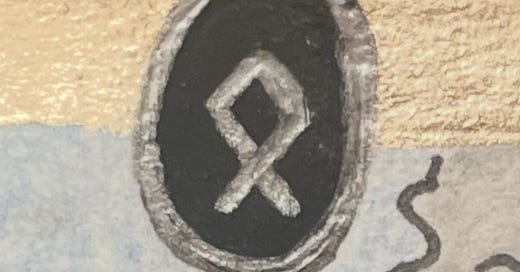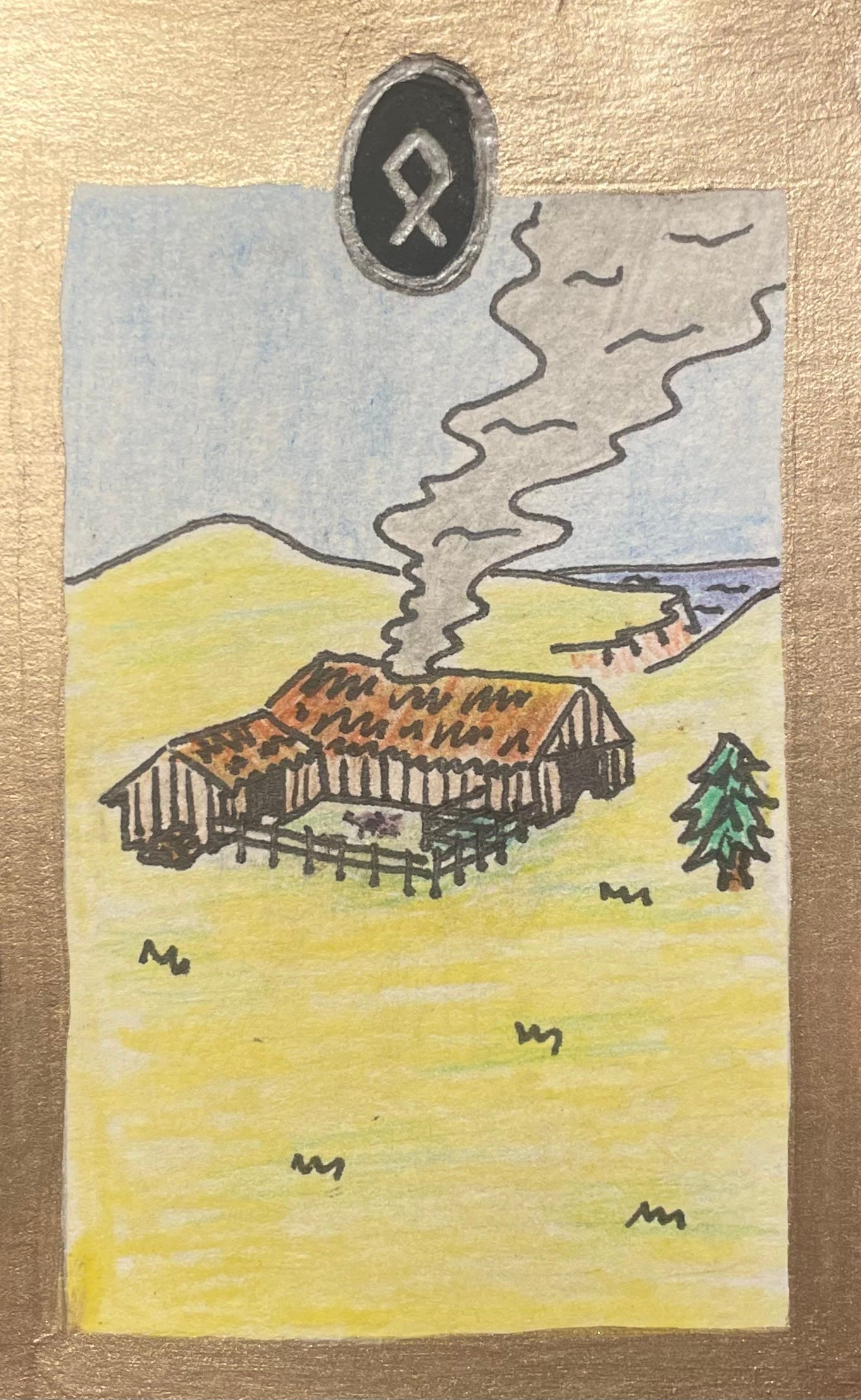I originally wrote this as a special studies paper in my last semester of college (2022), combining my two majors: Religion and World Literature. I’ve tried to break it down into more digestible sections (adding and subtracting a bit with updated knowledge), which I will be releasing over the next few weeks. So far it is 4 parts: historical background, the contemporary sphere, a discussion on philosophy and ancestry, and finally my personal experience with runes as psycho-ritual objects. It’s a topic I feel I only see discussed in one light or another: historical accuracy of bad fascists or love and light pagans claiming that the ancience of their beliefs excuses the baggage of history. As both a practitioner of the occult and a lover of history, my goal is to help people think more critically about why symbolism is an effective way of moving nations (in positive as well as negative directions), about when it is essential we pay attention to it, and about how we might move in the world to make it safer for ourselves and our communities.
You can read Part 1 here.
Part 2: The Contemporary Sphere
In the year 2021, the Conservative Political Action Conference (CPAC), held in Hoboken, New Jersey, formed their convention stage in the form of the appropriated othila rune (with added tails on the “legs'' of the symbol) (Washington Post). This rune means “homeland,” a perfect anchor for the age-old agenda of ethnic cleansing: patriotism. The 2021 stage incident–which of course was vehemently denied and reported as an accident–is just one in a long history of dog whistles.
an artistic interpretation of the Othila rune, by me, circa 2021ish (colored pencil)
In his 2018 article, Paul Mountfort cites Mattias Gardell’s In Gods of the Blood: the Pagan Revival and White Separatism (2003), where he observed “fringe groups at the darker end of the Anglophone Germanic revival, including Aryan Revolutionary Paganism, Ethnic Ásatrú, “Darkside” Ásatrú, and Occult National Socialism.” These groups exist within the “wider context of racist and reactionary religious dogmas in the US…affiliated with European counterparts… also commonly conscript[ing] runes into their iconography and rites...” It doesn’t only happen on a political level like the CPAC stage, but online, in music, all over popular culture– “white-racist publications, Web pages, and white power lyrics reveals muscular heathens, pagan gods and goddesses, runes and symbols, magic and esoteric themes in abundance” (23).
The insistence on blood status is known as folkism, or volkism, a perversion of the Heathen values of protecting your own people.
“Folkism...is the exclusionary belief that your ancestral connections (your DNA and heritage) makes your connection to a spiritual practice more special than someone without said connection. Folkism also tends to feel that only people of that heritage, in this case Heathenry, should be practiced by people with that genetic ancestry... Folkism insists that a blood connection to ancestors offers an edge to a spiritual path over those who may not have the same heritage. There’s nothing wrong with finding out you have a strong Germanic connection through a DNA test and that makes you look into Heathenry, but it is folkish to assert that it makes you, somehow privileges you, to follow that path...In Heathenry, we are called to be aware of how we interact with and respect others both personally and as a group. The concept is called innengarð, which is the members of your kindred, family, or friends as well as members of your faith versus those outside of it which is known as the outengarð. Innengarð and outengarð were historically about those within the law and the protection of it versus those who are outside of it. Folkism is all about weaponizing the innengarð/outengarð concept and turning it into us vs. them. It’s what drives white nationalism, racism, and other exclusionary viewpoints based around dislike and hatred towards the ‘Other’” (The Wild Hunt Journal).
The memory of fascism is not absent from modern communities and calling it out is actually a pretty integral part of rune lore today, as evidenced by this condemnation, as well as movements like Declaration 127; The Poetic Edda poem Havamal consists of sayings of Odin’s wisdom, and verse 127 states: “When you see misdeeds, speak out against them, and give your enemies no [peace].” This declaration was specifically made in response to the Asatru Folk Assembly putting out exclusionary statements to the effect of Heathenry only being for white heterosexuals. While this now serves as a functional filter for groups practicing outright exclusivity, but many still feel it does not go far enough. “By focusing the statement primarily on the AFA, it weakens a statement that many Heathen groups want it to address: inclusivity and universalism over exclusion and folkism” (The Wild Hunt, “Enacting Declaration 127”).
Still, like any discipline, runology is made up of humans, inherently flawed, caught up in systems wrought by circumstance. The truth of it is, we do not know exactly how the ancient Vikings viewed the runes, given their extensive and varied uses over the centuries and lands, and we never will. It is a reconstructed belief system in the way that diaspora religions (Judaism, Voodoo, etc.) are not, though they certainly have their share of reconstruction as well. Runic occultism is massively pieced together and its practice is deeply associated with other spheres of occult influence, which, like New Ageism, have often been appropriated from Eastern and Jewish mysticisms. It is a practice that must be constantly reinvented, and the source material available to us often carries echoes of Gothic Revival propaganda. (Read more about this part of the history in part 1).
These reinventions perform a consistent historical pattern: periods of cultural suppression under which occult milieu becomes subversive (think, conservative modernism: the Victorian Era, the Reagan Era, etc.), bleeding into eras where occult milieu is neoliberally appropriated into the status quo, used by the state and dominant cultural movements for entertainment, political power, and profit (think, 1900s saloon seances, Nazi appropriation of runes in the 1950s, the 1960s counterculture movement sparking the rise of the New Age, postmodernism, and then contemporary, post-information era institution of commerce in the form of brands, websites, etc.). It is a push and pull between sacred and profane, what is used for justice, survival, and connection, versus what is used to take advantage of and exert power over others.
I believe it is essential to discuss these negative historical associations, because only through understanding our past can we truly begin to make a difference for our future. Take the massive rise in school shootings in the last twenty years, or incidents like the Charlotteville protests on the University of Virginia campus in 2017, or the riot at the capitol on January 6th, 2020. Such incidents occur seemingly more than ever as the years pass. People come out of the woodwork when they feel empowered by the state to take their own cleansing action (of whatever their beliefs may be), and the unfortunate truth is, that like the incident with the GOP stage in New Jersey (and infinite situations since), it has been made clear that the American government is managed by people who either condone it or don’t care enough not to. (From 2025— this massive understatement would be funny if it weren’t so pressingly, horrifyingly true.)
Join me next week as I move into the philosophical portion of this project, explaining why I believe the runes “work,” and even why fascist principles hamper us in such a process. Later, I will go back to my own beginnings to share my connection to the subject, outside of academic study.




